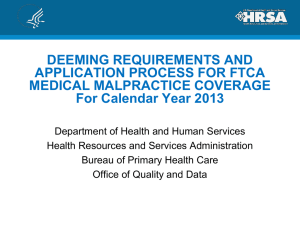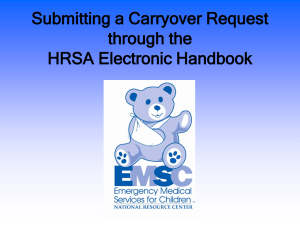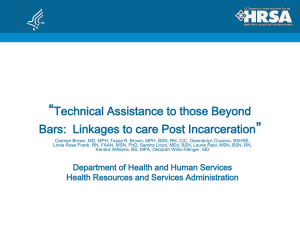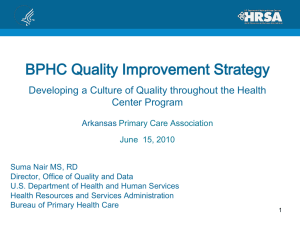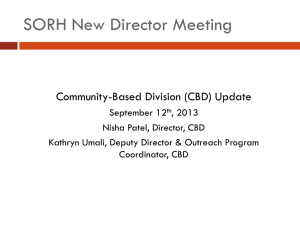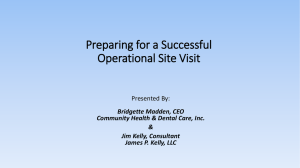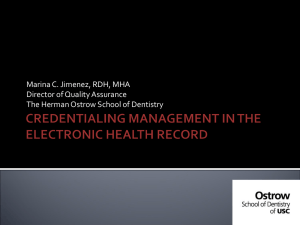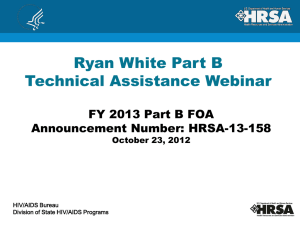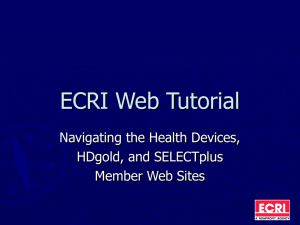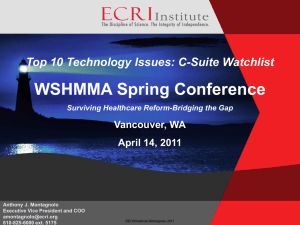Presentation - North Carolina Community Health Center Association
advertisement
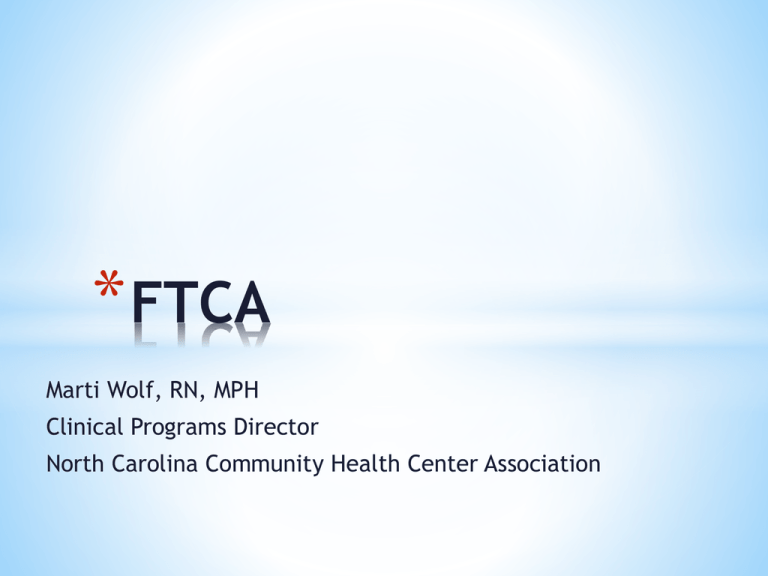
* FTCA Marti Wolf, RN, MPH Clinical Programs Director North Carolina Community Health Center Association 1. When submitting FTCA application, it should include all providers, including new hires who are not yet working at the health center. 2. Minutes of meetings are adequate for documenting Board approval. 3. We are Joint Commission Accredited. Therefore our Credentialing/Privileging meets or exceeds HRSA standards. 4. QI/QA and Risk Management Plans should be approved every 3 years. 5. For Peer Review, NPs and PAs can review MDs. * *Remember you are working a year in advance *2014 FTCA applications went in March 2013 *Annual Re-deeming *New deeming can be done any time during the year * *Credentialing and Privileging *Quality Improvement *Risk Management *Peer Review FTCA “Bibles” PIN 2001-16 PIN 2002-22 Annual PIN * * *Assess, identify, analyze *Control/avoid/minimize/eliminate events *Cause a loss to the organization *Adverse outcomes *Harm *Proactive instead of Reactive * *Risk Management is comprehensive of the entire organization. *Risk Management is Board driven and Board overseen. *Risk Management and/or QI programs audit Cred/Priv processes to ensure compliance. *Risk Management PLAN https://members2.ecri.org/Components/HRSA/Pages/PSRMPol10.aspx * *Governance *Administrative *Business/Finance *Environment *Human Resources *IT *Clinical * *Clinical risk management includes: *Annual risk assessment *Clinical protocols *Peer reviews *Supervision of health center staff: clinical and nonclinical *Medical records policies *Triage policies (walk-in and phone) *No show appointment policies *Tracking policies: referrals, hospitalizations and diagnostic testing * * NonClinical Building and Grounds- Safety and SecurityEquipment management-Board ResponsibilitiesContracts and Procurement- Record RetentionCorp/Regulatory/Grant Compliance-Disaster Prep- Incident Report managementFinance/billing- Human Resources compliance (FMLA, at will employment)- Staff TrainingCredentialing-IT (backup, security levels)Patient satisfaction- Disaster Response- HIPAA * *Staff training in Risk Management *Description of available opportunities *Process to ensure staff receive RM training * *Training Topics- depending on your Scope *Patient safety *OSHA *Infection control/hand hygiene *Bloodborne Pathogen *Teamwork and communication *Hazard *Medication safety Communication/ Disclosure *Fall prevention *Hand Hygiene *Fire safety *Sharps Injury *Documentation Prevention *Disaster planning *PPE *MSDS *Obstetrics safety * Prevention of Medical Malpractice *Scope of grant and privileging *Clinical outcomes measurement *Event/incident monitoring *Supervisory agreements *NPDB *Claims reviews * Implementation is documented by *P/P *Training- right up to BOD *Data on RM activities *Minutes showing data being reviewed *Solutions to identified problems are implemented *On-going monitoring and risk assessment *Board reports * P/P *Triage *No shows *Supervision of staff *Referrals/Hospitalization/Diagnostics * * • Plan should include: –Statement of purpose –Scope of plan –Administrative responsibility –Risk management systems –Committee membership –Committee accountability –Activities; tracking –Approval; review – – * https://members2.ecri.org/Components/HRSA/Pages/PSRMPol20.aspx https://members2.ecri.org/Components/HRSA/Pages/PSRMPol21.aspx • QI and Board meeting minutes should: –Include specific data about ongoing QI projects –Report performance on selected measures from QI plan –Progress on goals for QI program –MINUTES FROM ANY 6 MEETINGS* * Clinical Protocols *Frequent conditions *Standards of Care *Updated *Provider/clinical staff training *Peer review based on Clinical Protocols *QI metrics * * Credentialing: The process of assessing and confirming the qualifications of a licensed or certified healthcare practitioner to render specific health care service(s). Privileging: The process of granting the qualified health care provider (Licensed independent practitioners ) the permissions to render specific health care services and perform specific health care procedures for a limited time (2 years). * *AND is the operative phrase *Credentialing IS NOT THE SAME as Privileging * • Ensures all health care providers (LIP’s) and clinical staff (licensed and certified) are qualified to render the type of care for which they are employed. • Involves evaluating a practitioner’s eligibility to provide clinical services at the health center and evaluating the provider’s competency for specific clinical privileges. • Failure to fully credential may result in liability if a patient is harmed. * *Policy Information Notice (PIN) 2001-16, Credentialing and Privileging of Health Center Practitioners requires that "all Health Centers assess the credentials of each licensed or certified health care practitioner to determine if they meet Health Center standards." This policy applies to all health center practitioners, employed or contracted, volunteers and locum tenens, at all health center sites. http://bphc.hrsa.gov/policiesregulations/policies/pin200222.html * *You must comply with HRSA policies *Joint Commission or other accreditation/recognition bodies do not supersede HRSA requirements *Must comply with any state regs *Cross check with your Scope to ensure they match your privileging/services provided * • DOCUMENTATION: Attachment E: upload the credentialing list (excel spread sheet). * *On your credentialing list *All practitioners, employed or contracted, volunteer and locum tenens *From all of your sites *ONLY THOSE CURRENTLY WORKING AT TIME OF THE SUBMISSION * DOCUMENTATION: ATTACHMENTS F1 AND F2 *Approval of the Cred/Priv POLICY *F1- your credentialing and privileging POLICY *Board approved- date and signature of board chair *F2- board minutes as proof of board approval *Signed and dated and clearly indicate board approval of the Policy * *Credentialing PROCEDURE (plan) *Addresses your duty to care for patients and prevent harm *STEP by STEP PROCESS *Provides for on-going education, training and licensure/certification *“Provides a clear pathway… to hire and/or dismiss clinical staff” *All LIPs, and other licensed/certified practitioners * *TIPS For a HAPPY Credentialing Plan *HRSA likes to see the PINS referenced in the Policy and Procedure *Specifically indicates when primary and 2ndary sources are used (… see PINs ) *Specifies re-credentialing every 2 years *Includes Board approval or specifies how Board approval of Policy and Credentialing are delegated *Policy and Plan should be approved and resigned every 3 years * *Common Confusion *PRIMARY SOURCE VERIFICATION * Direct written correspondence * telephone * Internet * CVO report (cred verification org) * AMA Master File, other medical boards *SECONDARY SOURCE VERIFICATION * Original credential * Notarized copies * Copy of credential – must be made by approved health center staff member * * Primary source verification for LIPs is obtained for the following: * Applicant’s license * Applicant’s education, training, experience * Applicant’s registration * Application’s certifications * Applicant’s current competence * Applicant’s ability to perform services for which privileges are requested * Secondary source verification for LIPs is obtained for the following: * Government-issued photo ID * DEA registration (if applicable) * Hospital admitting privileges (if applicable) * Immunization and PPD status * * Primary source verification for other providers is obtained for the following: * Applicant’s license * Secondary source verification for other providers is obtained for the following: * Applicant’s education, training, experience * Applicant’s registration and certifications * Applicant’s current competence * Applicant’s ability to perform services for which privileges are requested * Government-issued photo ID * DEA registration (if applicable) * Hospital admitting privileges (if applicable) * Immunization and PPD status * *CHECKLIST of required information Curriculum vitae (CV) Diplomas (e.g., undergraduate, post-graduate, medical school, residency, fellowship) Statement confirming health fitness Certificates (e.g., board certification, BLS, ACLS) Medical licenses Drug Enforcement Administration (DEA) registration (if applicable) Controlled Dangerous Substances (CDS) registration (if applicable) Peer references * But Wait! There’s MORE! information CHECKLIST of required Proof of liability insurance Summary of malpractice claims/adverse actions filed against the provider National Practitioner Data Bank (NPBD) query q 2 yr Delineation of privileges Government-issued picture identification Immunization and PPD status Life support training (if applicable) Fit for duty Verification of hospital and/or facilities privileges * *Maintain complete and organized required credentialing documentations and records. *Regularly identify expiring credentials before expiration *Review each file once per year to identify any missing items. *If you use a credentials verification organization (CVO): * Ensure the CVO understands FTCA requirements. *The contract with the CVO speaks to privacy, document owners, document retention. *Ensure your privacy release (signed by LIP) speaks to the use of a CVO by the organization. Your responsibilities *Each practitioner should be privileged specific to the services prior to rendering services. *Privileging processes verifies clinical privileges and medical staff membership at local facilities (admitting privileges, etc) *Renewal or revisions of privileges for LIPs and other licensed or certified practitioners must occur at least every two years. *Full and temporary privileges need to be clearly defined (time limited with only specific reasons for temporary).- at least q 2 yrs *Providers must be privileged prior to rendering health care services. * *Approved applicants are notified in writing within a defined timeframe. *Approved applications and a copy of the approval letter are forwarded to appropriate internal personnel within a defined timeframe. *Applications whose requests are denied are notified within a defined timeframe. *The health center has a defined policy for making changes to final approved/denied applications. *Board must approve privileges or must formally delegate this activity to a committee *Board must document approval of privileges * Peer Review is a QI process *Quality of care *Patient safety *Learn from past performance, errors, near misses *Is integral to credentialing and privileging *Per FTCA, Midlevels can review MDs * *Who is in charge of Peer Review Process *Duties/Responsibilities of that person *Frequency of review *Number of charts reviewed per provider *How feedback is communicated and documented *Maintains pt confidentiality during the process *How peer review is communicated to BOD *Methodology for improvement strategies * * REFERRAL/HOSPITALIZATION/DIAGNOSTIC TRACKING P/P * QUALITY IMPROVEMENT PLAN AND ACTIVITIES * 1. When submitting FTCA application, it should include all providers, including new hires who are not yet working at the health center. 2. Minutes of meetings are adequate for documenting Board approval. 3. We are Joint Commission Accredited. Therefore our Credentialing/Privileging meets or exceeds HRSA standards. 4. QI/QA and Risk Management Plans should be approved every 3 years. 5. For Peer Review, NPs and PAs can review MDs. * *FTCA/BPHC Help Line *Phone: 1-877-974-BPHC (877-974-2742) *9:00 AM to 5:30 PM (ET) *Email: BPHChelpline@hrsa.gov *FTCA Website: http://www.bphc.hrsa.gov/ftca/ *HRSA Quality Improvement Webinars: http://bphc.hrsa.gov/policiesregulations/quality/ * * Sample Risk Management Policy: Physician Office Practice https://members2.ecri.org/Components/HRSA/Pages/PSRMPol3.aspx * * Patient Satisfaction Questionnaire https://members2.ecri.org/Components/HRSA/Pages/PSRMPol2.aspx * * Handling Patient Complaints https://members2.ecri.org/Components/HRSA/Pages/OAPol3.aspx * * Risk Management Plan: https://members2.ecri.org/Components/HRSA/Pages/RMPlan.aspx * Webinars https://members2.ecri.org/Components/HRSA/Pages/Webinar_Audioconf_Archive.aspx: Anecdotal Note for Patient Concerns https://members2.ecri.org/Components/HRSA/Pages/OAPol4.aspx Safety Attitudes Questionnaire (Ambulatory Version) https://members2.ecri.org/Components/HRSA/Pages/PSRMPol1.aspx Event Reporting Toolkit: https://members2.ecri.org/Components/HRSA/Pages/EventReportToolkit.aspx * * * Clinical Risk Management Basics Part I Developing a Risk Management Plan ECRI Resource Page: Quality Improvement: https://members2.ecri.org/Components/HRSA/Pages/QI.aspx *
